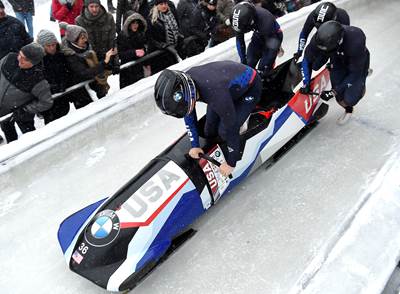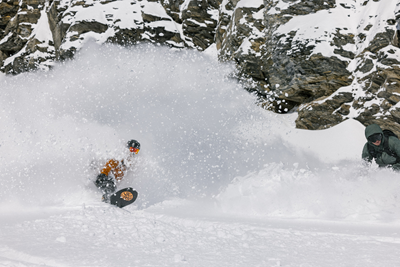CRP USA 3D printing composites meet critical needs of bobsledding sport
Components critical to a bobsled’s functionality — push handles, hand grips and seats — were tailored from Windform materials, heightening both performance and safety for athletes’ racing in the 2026 Winter Olympics.
USABS team with Brian Shimer, head coach; Curt Tomasevicz, high-performance director; and Marc van den Berg, technology and equipment lead at CRP USA’s headquarters during wind tunnel testing. Photo Credit: USABS
3D printing company CRP USA (Mooresville, N.C., U.S.) teamed up with the United States Bobsled and Skeleton Federation (USABS, Colorado Springs, Colo., U.S.), crafting race-ready 3D-printed composite components for the USABS’ bobsled to use in sliding season and the Winter Olympics. The parts improved the athletes’ performance, guaranteeing increased stress resistance, flexibility, strength and the ease of switching/replacing parts as needed.
Bobsledding, an iconic fixture of the Winter Olympics, dates back to the late 19th century, embodying the pursuit of velocity and technical finesse. The essence of bobsledding hinges on maximizing acceleration at the race’s onset while mitigating forces that impede speed — a delicate balance achieved through a fusion of adept teamwork, superior equipment and the nuances of the course. In recent years, industrial 3D printing has been used to create customized winter sports’ equipment — such as helmets and spike attachment — to improve performance and athletes’ safety, and this collaboration proved no different.
Recognizing the needs behind bobsledding equipment, the USABS embarked on an endeavor to create next-generation bobsleds for the forthcoming 2026 Olympic Winter Games. The initiative brought together diverse domestic partners under the “Made in-USA” project, including CRP USA and a local carbon fiber products company, ushering in an exploration of materials and manufacturing processes.
Windform materials contributed to crucial bobsled components, such as those shown here. Photo Credit: CRP USA
CRP USA’s contributions encompassed a suite of 3D-printed components — composed of the company’s Windform high-performance composite materials — that are crucial to the bobsled's functionality: push handles, hand grips and seats. Specifically, Windform SP was used for push handles and Windform XT 2.0 for hand grips and seats, both of which are carbon fiber-filled polyamide materials from the Windform Top-Line range of materials (i.e., selective laser sintering).
The strategic choice of materials underscores their resilience, capable of withstanding substantial forces and stress encountered during the races. Moreover, the absence of molds in the 3D printing process not only expedited production but also curtailed costs, enabling rapid iteration and customization based on the team’s evolving needs.
What were some critical issues that the USABS team had to face and overcame with 3D printing and Windform? “Complying with the regulations, in terms of shapes and dimensions” Marc van den Berg, technical and equipment lead at USABS, says, “was the main constraint.” Another factor was stress resistance. “During the start of the races there are large forces on the bobsled,” van den Berg adds. “Also, bobsled crashes must be considered. For those reasons, the construction materials have to be flexible and strong, in order to avoid parts breakage.”
The efficacy of 3D printing in crafting push handles serves as a testament to the process’ efficiency when coupled with adept technical guidance and a keen understanding of athletes’ requirements. The adaptability and durability of Windform SP made it an optimal choice for these critical components, tailored to individual athletes and swiftly replaceable as needed.
“The USABS team needed to easily produce the push handles, in addition to customize the handles based on each athlete and easily change them out,” Nathanael “Nate” Baker, senior project coordinator for CRP USA, says.
The iterative process of testing and modification, facilitated by CRP USA’s swift manufacturing and delivery, enabled the USABS team to fine-tune these parts for optimal performance. Real-world validation came through actual race deployment, where the 3D-printed parts excelled, demonstrating resilience even during bobsled crashes.
“The biggest requirement of the rear push levers [for example] is that they must remain intact if the bobsled crashes,” van den Berg says. “And that is what happened in this race; the bobsled crashed, but the handles were not broken. Hopefully we can 3D print more parts in the future, perhaps even a complete bobsled.”
The official debut of these 3D-printed components at the IBSF North American Cup in November 2023 yielded resounding success for the USABS team, clinching victories across multiple categories.
“The athletes have waited a long time to get back on the ice and begin competing,” Curt Tomesevicz, director of sport performance for USABS, notes. “So, it was very rewarding to see so many great results. It is the reward of a lot of hard work in the off-season.”
Related Content
The lessons behind OceanGate
Carbon fiber composites faced much criticism in the wake of the OceanGate submersible accident. CW’s publisher Jeff Sloan explains that it’s not that simple.
Read MoreWelding is not bonding
Discussion of the issues in our understanding of thermoplastic composite welded structures and certification of the latest materials and welding technologies for future airframes.
Read MorePEEK vs. PEKK vs. PAEK and continuous compression molding
Suppliers of thermoplastics and carbon fiber chime in regarding PEEK vs. PEKK, and now PAEK, as well as in-situ consolidation — the supply chain for thermoplastic tape composites continues to evolve.
Read MorePlant tour: Teijin Carbon America Inc., Greenwood, S.C., U.S.
In 2018, Teijin broke ground on a facility that is reportedly the largest capacity carbon fiber line currently in existence. The line has been fully functional for nearly two years and has plenty of room for expansion.
Read MoreRead Next
Solvay, deBotech announced as USA Bobsled and Skeleton technology partners
Solvay and deBotech will provide custom designed high quality carbon fiber composite equipment.
Read MoreCRP 3D printing composites optimize Formula SAE team’s racing performance
Long-term CRP USA and UVic Formula Racing partnership has culminated in the development of versatile, durable carbon fiber-filled components that continue deliver on the track.
Read MoreBio-based epoxy, recycled materials increase sustainability of all-terrain snowboards
Aiming for a smaller environmental footprint while maintaining high performance, Salomon’s Highpath snowboard line incorporates bio-based epoxy, glass and basalt fiber stringers and recycled materials.
Read More




























